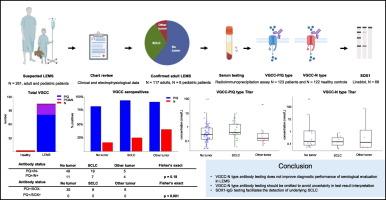N-type voltage-gated calcium channel antibody testing lacks diagnostic value in Lambert-Eaton myasthenic syndrome
IF 2.5
4区 医学
Q3 IMMUNOLOGY
引用次数: 0
Abstract
Introduction/aims
Diagnostic evaluation for Lambert-Eaton myasthenic syndrome (LEMS) includes serological testing for voltage-gated calcium channel antibodies (VGCC-P/Q-type [VGCC-PQ] and VGCC-N-type [VGCC-N]). While VGCC-PQ antibodies are well-established biomarkers in LEMS, the clinical utility of VGCC-N antibody testing remains obscure. We aimed to determine the diagnostic value of VGCC-N antibody testing.
Methods
A retrospective cross-sectional study was performed. The Mayo Clinic electronic medical record from 1995 to 2021 was reviewed for inclusion of patients fitting clinical electrodiagnostic criteria for LEMS, who were evaluated for serum VGCC antibodies (n = 123). Available sera were additionally tested for SOX1 antibodies (n = 68). Healthy adults were tested for VGCC-PQ and VGCC-N antibodies (n = 122). Clinical performance of each antibody test was evaluated statistically.
Results
Among adult LEMS cases, 84.6 % (n = 99/117) tested positive for VGCC-PQ antibody while none of the healthy controls did. In contrast, 20.5 % (n = 24/117) were VGCC-N antibody positive, of which 95.8 % (n = 23/24) co-occurred with VGCC-PQ antibodies. The frequency of isolated VGCC-N antibody positivity was higher in controls than in LEMS (2.5 % [n = 3/122] vs. 0.9 % [n = 1/117]), and pediatric patients had no VGCC-N antibody reactivity. Neither VGCC-N antibody positivity nor titer was predictive of an associated small-cell lung cancer (SCLC-LEMS). By contrast, SOX1-IgG seropositivity associated significantly with SCLC-LEMS.
Discussion
Inclusion of VGCC-N antibody testing does not improve diagnostic accuracy for LEMS, nor does it serve as a predictor of LEMS-associated cancers in contrast to SOX1-IgG testing. We recommend the exclusion of VGCC-N antibody testing given its non-specific disease associations and poor positive predictive value in LEMS screening.

n型电压门控钙通道抗体检测在Lambert-Eaton肌无力综合征中缺乏诊断价值
介绍/目的Lambert-Eaton肌无力综合征(LEMS)的诊断评估包括血清学检测电压门控钙通道抗体(VGCC-P/ q型[VGCC-PQ]和VGCC-N型[VGCC-N])。虽然VGCC-PQ抗体是LEMS中公认的生物标志物,但VGCC-N抗体检测的临床应用仍然模糊不清。我们的目的是确定VGCC-N抗体检测的诊断价值。方法采用回顾性横断面研究。回顾Mayo诊所1995年至2021年的电子病历,纳入符合LEMS临床电诊断标准的患者,并对其血清VGCC抗体进行评估(n = 123)。另外对可用血清进行SOX1抗体检测(n = 68)。健康成人检测VGCC-PQ和VGCC-N抗体(n = 122)。对各项抗体检测的临床表现进行统计学评价。结果成年LEMS患者中VGCC-PQ抗体阳性的占84.6% (n = 99/117),健康对照组无阳性。20.5% (n = 24/117)血清VGCC-N抗体阳性,其中95.8% (n = 23/24)血清VGCC-PQ抗体阳性。对照组分离VGCC-N抗体阳性频率高于LEMS组(2.5% [n = 3/122] vs. 0.9% [n = 1/117]),患儿无VGCC-N抗体反应性。vgc - n抗体阳性和滴度都不能预测相关的小细胞肺癌(SCLC-LEMS)。相比之下,SOX1-IgG血清阳性与SCLC-LEMS显著相关。与SOX1-IgG检测相比,纳入vgc - n抗体检测并不能提高LEMS的诊断准确性,也不能作为LEMS相关癌症的预测因子。我们建议排除VGCC-N抗体检测,因为它在LEMS筛查中的非特异性疾病相关性和较差的阳性预测值。
本文章由计算机程序翻译,如有差异,请以英文原文为准。
求助全文
约1分钟内获得全文
求助全文
来源期刊

Journal of neuroimmunology
医学-免疫学
CiteScore
6.10
自引率
3.00%
发文量
154
审稿时长
37 days
期刊介绍:
The Journal of Neuroimmunology affords a forum for the publication of works applying immunologic methodology to the furtherance of the neurological sciences. Studies on all branches of the neurosciences, particularly fundamental and applied neurobiology, neurology, neuropathology, neurochemistry, neurovirology, neuroendocrinology, neuromuscular research, neuropharmacology and psychology, which involve either immunologic methodology (e.g. immunocytochemistry) or fundamental immunology (e.g. antibody and lymphocyte assays), are considered for publication.
 求助内容:
求助内容: 应助结果提醒方式:
应助结果提醒方式:


